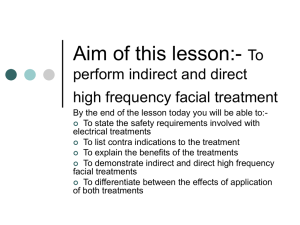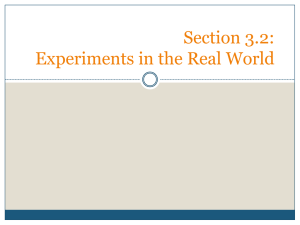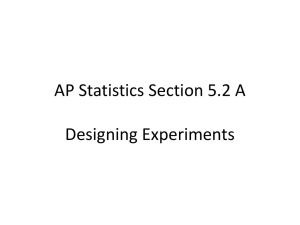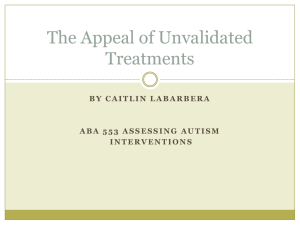Developing Treatments for Ataxia
advertisement
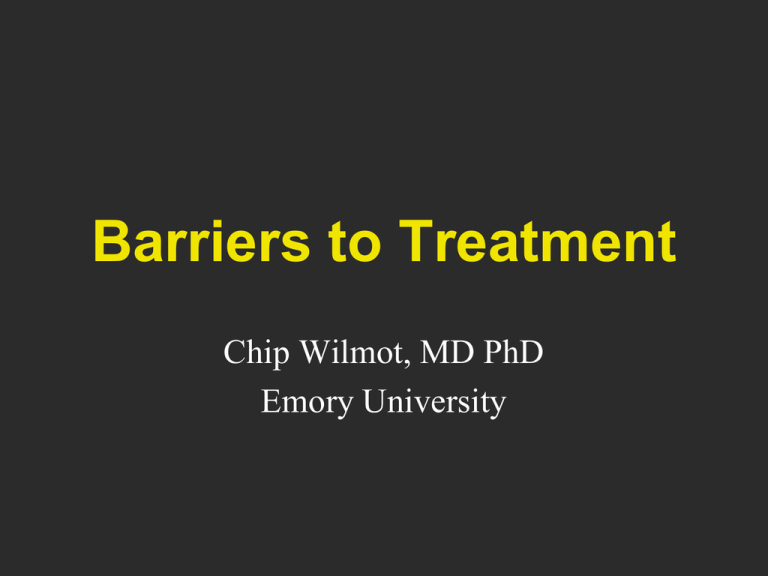
Barriers to Treatment Chip Wilmot, MD PhD Emory University Disclosure • Member, Data Safety Monitoring Board for studies involving Idebenone (Santhera Pharmaceuticals) “Why Don’t We Have A Treatment for Ataxia Yet?” -anonymous at NAF AMM 2012 “Why Don’t We Have A Treatment for Ataxia Yet?” -anonymous at NAF AMM 2012 and FAPG and GAASG and my clinic and … “Why Don’t We Have A Treatment for Ataxia Yet?” -Chip Wilmot, MD, PhD Emory University Treatment the care and management of a patient to combat, ameliorate, or prevent a disease, disorder, or injury. Cure A method or course of medical treatment used to restore health. Cure A method or course of medical treatment used to restore health. Don’t forget about prevention (at least for dominant SCA’s) Treatment -Symptomatic -pain, cramps, depression, mobility -Disease-modifying -slowing the rate of progression “Why Don’t We Have A Treatment for Ataxia Yet?” -Developing a treatment is HARD “Why Don’t We Have A Treatment for Ataxia Yet?” -Developing a treatment is HARD -Expectations for treatments can be unrealistic “Why Don’t We Have A Treatment for Ataxia Yet?” -Developing a treatment is HARD -Expectations for treatments can be unrealistic -We are doing a good job, but … “Why Don’t We Have A Treatment for Ataxia Yet?” -Developing a treatment is HARD -Expectations for treatments can be unrealistic -We are doing a good job, but … - … there are certainly ways to facilitate treating ataxia Clinical Disease Treat Human Disease Clinical Disease Etiology (Cause) Model Disease Treat Model Treat Human Disease Clinical Disease Etiology (Cause) Model Disease Treat Model Treat Human Disease Clinical Disease Etiology (Cause) Model Disease Treat Model Treat Human Disease Clinical Disease Etiology (Cause) Model Disease Treat Model Treat Human Disease Clinical Disease Etiology (Cause) Model Disease Treat Model Treat Symptoms Treat Human Disease Treat Disease What is needed to develop effective treatments? 1. Knowledge of the disease pathophysiology 2. A way to measure the disease 3. An understanding of the natural history of the disease 4. Research Infrastructure What is needed to develop effective treatments? 1. Knowledge of the disease pathophysiology -the cause – -ataxia genes galore -downstream consequences, e.g mitochondrial dysfunction in FRDA -insights into cerebellar (dys)function What is needed to develop effective treatments? 1. Knowledge of the disease pathophysiology -the cause -relevant models -mice, fruit flies, worms, etc. What is needed to develop effective treatments? 1. Knowledge of the disease pathophysiology -the cause -relevant models -candidate treatments -EPI-743, pioglitazone, lithium, riluzole, VEGF FRDA Timeline Treatment Trials Natural History Studies Begun Outcome Measures Gene Discovered Validated First clinical description 1863 1980 1990 2000 2010 What is needed to develop effective treatments? 1. Knowledge of the disease pathophysiology -the cause -relevant models -candidate treatments 2.A way to measure the disease -clinical scales, instrumented measures, biomarkers What is needed to develop effective treatments? 1. All the preliminary info: -the cause -relevant models -candidate treatments 2. A way to measure the disease 3. An understanding of the natural history of the disease -rate of progression -variability What is needed to develop effective treatments? 1. All the preliminary info: -the cause -relevant models -candidate treatments 2. A way to measure the disease 3. An understanding of the natural history of the disease -rate of progression -variability 4. Research Infrastructure -ataxia centers -$$$ -research subjects IS THIS TREATMENT EFFECTIVE? IS THIS TREATMENT EFFECTIVE? IS THIS TREATMENT EFFECTIVE? Lynch, D. R. et al. Arch Neurol 2010;67:941-947. Copyright restrictions may apply. How can the likelihood of a positive trial be improved? How can the likelihood of a positive trial be improved? 1. Reduce variability -large numbers -homogeneous study population -precise measures How can the likelihood of a positive trial be improved? 1. Reduce variability -large numbers -homogeneous study population -precise measures 2. Increase trial timeline How can the likelihood of a positive trial be improved? 1. Reduce variability -large numbers -homogeneous study population -precise measures 2. Increase trial timeline 3. Use a more effective treatment How can the likelihood of a positive trial be improved? 1. Reduce variability -large numbers -homogeneous study population -precise measures 2. Increase trial timeline 3. Use a more effective treatment Note: These are not always possible What can be done to facilitate treatment development? 1. Learn from other diseases ALS ALS vs. ataxia -ALS is 90% sporadic; pathophysiology not well understood -Quicker progression, more definite clinical measures What can be done to facilitate treatment development? 1. Learn from other diseases 2. Don’t disregard low lying fruit!!! -non-sexy treatments ARE available -(e.g. ALS PEG tubes and ventilatory support) What can be done to facilitate treatment development? 1. Learn from other diseases 2. Don’t disregard low lying fruit!!! -non-sexy treatments ARE available What can be done to facilitate treatment development? 1. Learn from other diseases 2. Don’t disregard low lying fruit!!! -non-sexy treatments ARE available 3. Never underestimate the power of dedicated action What can be done to facilitate treatment development? 1. Learn from other diseases 2. Don’t disregard low lying fruit!!! -non-sexy treatments ARE available 3. Never underestimate the power of dedicated action Thanks -Patients, families -Coordinators: Bettye Robinson RN, Sue Gronka RN -Colleagues -NAF, FARA, MDA, NIH
